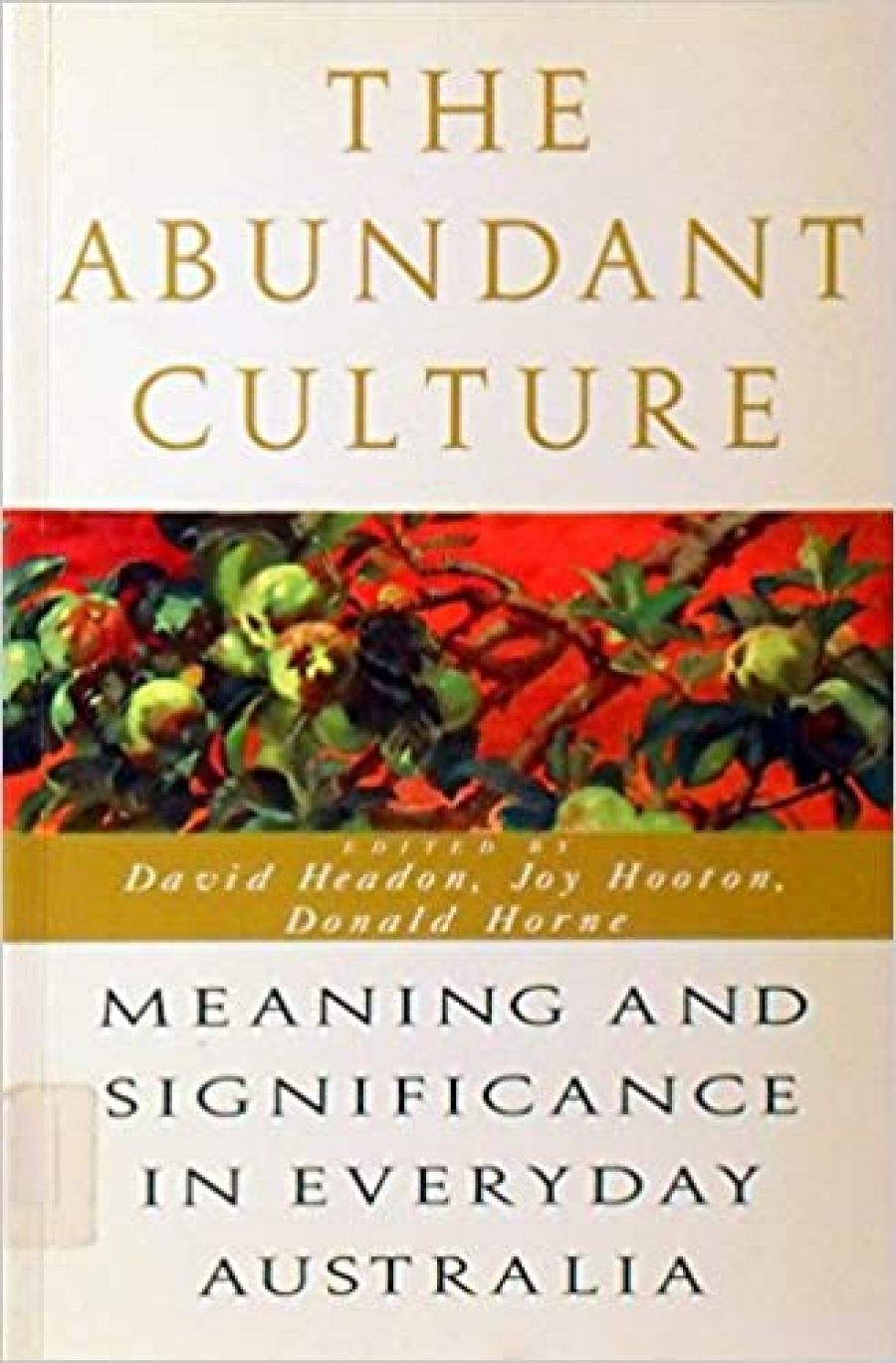
- Free Article: No
- Contents Category: Society
- Review Article: Yes
- Online Only: No
- Custom Highlight Text:
The way we organise our deaths offers insight into the meanings and significances we attribute to life. The sidelining of organised religion has allowed Australians to voice our own ideas about the muddles of existence through the choice of music for funerals. The regularity with which ‘I did it my way’ is heard at wakes is a reminder of how much more pertinent that song is for individuality than are newspaper columns by Bettina Arndt or Hugh Mackay, still less from Andrea Dworkin or the late Christopher Lasch.
- Book 1 Title: The Abundant Culture, Meaning and Significance in Everyday Australia
- Book 1 Biblio: Allen & Unwin, $24.95 pb
If Australians might be said to seek sermons in scones rather than through abstractions, how should such activities be investigated and described? To attach labels such as utilitarianism or pragmatism to our practices is to detach them from their common sense sources in doing rather than saying. But without a mode of criticism and a lexicon which stand outside our habits of being, can our particularities be distinguished? On the other hand, if those experiences are not retold on their own terms, are not their essentials being denied?
These dilemmas should have confronted contributors to The Abundant Culture with the question of how far to go in the direction of its subtitle. The late Barry Andrews might have joked about co-editing ‘The Oxford Mate to Australian Literature’, but the polished product was still called ‘Companion’. Much as the Jindyworobaks are laughed at today, they ended our poets’ reliance on English metaphors about carpets and aisles to evoke the Australian bush. Recent concern about the larding of cultural criticism with Frenglish has not broken through to a consideration of why Australian idioms remain unacceptable in scholarly prose. Les Murray’s vernacular republic is kept at bay by elevated cadences in the social sciences and the humanities.
‘Words fail us’ is the title of an insightful comparison by Judith Brett of the rhetorics of Keating and Hewson during the ‘Fightback!’ election campaign of 1993. What I would identify as Keating’s counterpointing of Jack Lang demagoguery with the bitchiness of Woollahra antique dealers has brought a new pitch to parliamentary life, one which Brett’s prose does not attempt to match, giving her title a different application.
The flight of researchers from High Art and Culture towards demotic subjects has not meant that those topics are analysed in their own terms. The academic treatment of the quotidian remains remote from the colloquial. Instead, the hieratic dominates scholarship about sport, with hardly a hint of the hyperbole of a H.G. Nelson. For example, Richard Cashman has not used the language of the outer or the change room to express his insights about the democratisation of cricket as one result of the Packer series. Instead, he writes in a jargon-free prose with an educated Australian tone, devoid of slang but with seven footnotes which direct attention towards concepts for reinterpreting the game.
In one of the most engaging pieces, Peter Read juxtaposes tales of two dispossessions during 1974, one of an Aboriginal mob from Elsey station, the other of market gardeners to make way for Brisbane’s new airport. The former were kept out of their home country by a padlock; the latter learnt to lock up their house once they shifted into the suburbs. Read relies on first person accounts, yet rounds off four-and-a-half pages of text with eleven footnotes. Is that weight of references the price that he knows must be paid if his social criticism is to be received with the seriousness it merits without them?
Authorial nervousness about what one’s peers might think afflicts the best pieces. For no demonstrated reason, Ann Curthoys and Kathryn Evans drag Bakhtin on carnivalisation into their splendid social history of reporters and subs on Sydney tabloids in the early 1950s, a practice which recalls the way that Soviet chemists felt obliged to open their learned papers with expressions of gratitude to Stalin. The master narrative has changed but a ritual of obeisance remains.
Other contributors keep well above the everyday. The Festival discussed is Adelaide’s, not Tamworth’s. Yet distinctions between High Culture and everyday life are not as clear-cut as either side might care to pretend. Strictly Ballroom grew out of the National Institute of Dramatic Art and that film’s director has had two successes with the Australian Opera. Mel Gibson plays Hamlet. The inclusion of the male duet from The Pearl Fishers in the film Gallipoli continues to draw audiences to one of the most tedious pieces in the operatic repertoire.
The editors of The Abundant Culture indicate that their collection is a forerunner to an encyclopaedia of Australian culture to be published by 2001. If their motive was to prepare for that major work, surely a roneoed bulletin like those produced for the Bicentennial History slices would have been sufficient. That long-term purpose would not have attracted Allen & Unwin were it not for the spread of tertiary cultural studies courses. So I have a book of tutorial readings to review.
On that assumption, let me say that the index is extensive but a guide to further reading is wanted. Beginners will be introduced to everyday debates as Craig McGregor celebrates the coast over the bush and David Headon welcomes the drift in our film-making away from a bush past towards an urban present in Romper Stomper.
Students will find a model for their assignments in Joy Hooton’s study of the Sylvania Waters series since she attaches that research to her previous investigations of autobiographies by Australian women. Few other contributors succeed in turning their expertise into highlights of their concepts, or even to a summary of their findings.


Comments powered by CComment